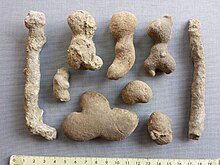Oste logs
Calcium concretions reminiscent of calcined bones are referred to as osteocolls (singular the osteocollas , from the Greek osteon "bone", kolla "glue") .
history
The term probably goes back to the "father of mineralogy", the Belgian Anselmus de Boodt (1609) (according to other sources to Conrad Gessner , 1565). The theologian Thomas Erastus reported in 1590 about calcified roots, which he called "lapis sabulosus", which he correctly referred to their origin in a sandy environment.
Emergence
The concretions were primarily created in the loess belt that had formed in the postglacial around the icy areas. They are the result of lime leaching close to the surface, with the lime reaching deeper sandy layers of soil through carbon dioxide-containing seepage water and being deposited there. Osteocollas need tree or bush roots to develop. The roots are calcified from the inside out. Measurements on osteocollas from the Mainz sand have shown that this process extends over a fairly long period of time (in this specific case 2500 years). Parts of these roots are often so well preserved that the plant species can still be identified.
Regional names such as "Lößkindl" (according to Duden, "Lösskindel"), "Lößmännchen" or "Lößpuppen" show that the relationship between the origin of the osteocolls and the presence of loess was recognized early on, but also the wealth of shapes of osteocolls stimulated people's imagination. Powdered osteocollas are said to have been used as a remedy for bone fractures in the Middle Ages.
Occurrence
Occurrences of osteocollas are, for example, from the area around Darmstadt, Mainz, Waiblingen, the Kaiserstuhl, the Mark Brandenburg, Berlin, south-west Poland, Frankfurt (Oder), from meltwater sands near Teterow (Mecklenburg-Western Pomerania), the Weinviertel (Lower Austria) and from Dummersdorfer Ufer known in Lübeck.
literature
- Georg Eberle: Osteokollen in the nature reserve "Dummersdorfer Ufer". In reports of the association “Nature and Homeland” and the Natural History Museum in Lübeck , issue 13/14, Lübeck 1975.
- Heilwig Leipnitz and Carla Möller: Pseudo- or mock fossils . In the journal of the Working Group Paläontologie Hannover, issue 4, pp. 1–15. Hanover 1983.
- Wolfgang Draw: About Osteokollen . In nature and in museums. Report of the Senckenbergische Naturforschenden Gesellschaft , 99 (4), pp. 145–154. Frankfurt a. M. 1969.
- Wolfgang Draw: Age regulations on Osteokollen . - In nature and museums. Report of the Senckenbergische Naturforschenden Gesellschaft , 102 (9), pp. 353–357. Frankfurt a. M. 1972.
Web links
- Working Group Paleontology Hannover, Journal for Amateur Paleontologists 1983 (PDF; 3.33 MB)
- Loesskindel
Individual evidence
- ↑ a b W. Schulz: Geological guide for the north German bed load collector. cw Verlagsgruppe, Schwerin 2003, ISBN 3-933781-31-0



